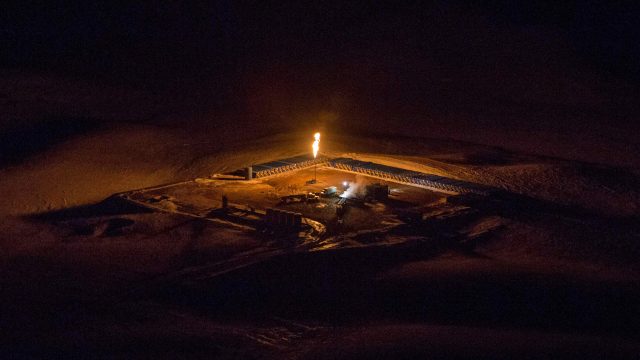North Dakota Industrial Commission Approves Oil Production Limits To Punish Excessive Flaring

Flaring is a problem in North Dakota, there’s no question. The oil fields here are just that – oil fields – but a lot of gas gets produced as a by-product of drilling, and there hasn’t been the sort of infrastructure in place to capture the gas.
Thus, the state of North Dakota has seen a 1,700 percent increase in the amount of gas flared, from over 616,000 MCF in April of 2005 to 11.2 million MCF in April of 2014. The industry has been trying to keep pace – it’s worth nothing that the amount of gas captured has increased 439 percent during this same time window, which is nothing to sneeze at – but the pace of oil production coupled with low gas prices providing little incentive to built out gas capture infrastructure has resulted in a big spike in flaring.
Currently, North Dakota flares over 30 percent of gas produced in the state (though a big chunk of that is happening on the Fort Berthold Indian Reservation where federal regulators have jurisdiction and flaring is over 46 percent). The oil industry has proposed a goal for dramatic reduction in flaring within a few years.
Today the North Dakota Industrial Commission – made up of Governor Jack Dalrymple, Attorney General Wayne Stenehjem and Agriculture Commissioner Doug Goehring – issued an order agreeing with the oil industry’s goals and proposing oil production limits for wells that don’t comply with gas capture protocols.
The entire order is below. First, here’s the goal proposed by the oil industry and adopted by the NDIC:

I believe we’ll probably see a flaring rate in the low 20’s this summer, possibly in the next report from the Department of Mineral Resources. The Hess gas plant in Tioga just re-opened after being closed for months for expansion. Once it begins having an impact on state gas capture, we’re going to see a significant reduction.
Still, this is an aggressive goal for flaring reduction. And to make sure the industry meets it, the NDIC approved this enforcement policy:

To put that into perspective, as of April the average daily oil production per well in North Dakota was 126 barrels per day, though that includes a lot of older wells. New wells – the sort that will now have to come under this order – are going to produce a lot more than that early on in their life cycle. A restriction to 200, or even 100, barrels per day for not hitting flaring guidelines is a significant penalty.
There is some flexibility for oil wells drilled on the Fort Berthold Indian Reservation where tribal and federal regulations must also be met, though I think if we’re going to talk about the flaring issue in North Dakota we should start setting aside the flaring on the reservation. It’s not really fair to hold state policymakers responsible for an area where they have little jurisdiction.




